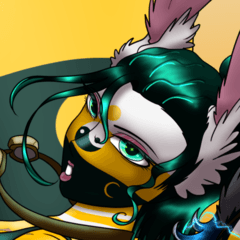

El vidrio parece primitivo Glass looking primitive
Me tomó muchos pasos conseguir esto, pero en general, es bastante simple.
Este es un ejemplo de cómo uso un cubo para simular el efecto de vidrio.

Fuente de luz: Aplique la fuente de luz pero no proyecte sombra ya que la luz la atraviesa. Puedes intentarlo de todos modos para ver la diferencia. Modelos que proyectan sombra en el suelo y otros modelos para ver la sombra tanto en el vidrio como a través del vidrio en otro modelo.
Transparencia: Dos formas de hacer un vidrio transparente. Ya sea en la propia capa antes de la textura importada/exportada o, y es más recomendable desde mi punto de vista porque no tienes que modificar ninguna textura en absoluto, en el "detalle de la subherramienta" en el propio cubo, selecciona el "Alfa" a "Semitransparente" y elige la intensidad que prefieras. En este ejemplo, elegí editar la textura directamente en lugar de ir al "Detalle de la subherramienta".
Estructura alámbrica: Mostrar estructura alámbrica. Puede optar por ocultarlo si desea un vidrio unificado.
Textura: Mi textura original tenía solo un marco de alambre de 3X3 en X, Y y Z. Después de exportar, reimportar y modificar la textura, la configuré hasta 12X12 en todos los lados dando este aspecto.
Efectos secundarios: Como puedes ver en la parte inferior puede haber un efecto indeseable. Esto se debe a la proximidad del "otro" lado. Para evitar eso, puede hacer el mismo proceso anterior en una primitiva de "plano". Pero le faltará la profundidad (grosor) del vidrio, ya que dos planos cercanos entre sí pueden tener el mismo efecto indeseable, pero menos.
Por favor, considera dejar un me gusta si te gustó,
¡Gracias!

It took me a lot of steps to get this, but over all, it is quite simple.
This is an example on how I use a cube to simulate glass effect.

Light source: Apply light source but do not cast shadow since the light goes through. You can try anyway to see the difference. Models casting shadow on ground and other models to see the shadow on both glass and through the glass on other model.
Transparency: Two ways to make it a transparent glass. Either on the layer itself before the imported/exported texture or, and it is more advisable to my point of view because you don't have to modify any texture at all, in the "sub tool detail" on the cube itself, select the "Alpha" to "Semi-transparent" and choose the intensity of your choice. In this example, I chose to edit the texture directly rather than going to the "Sub Tool Detail".
Wireframe: Show wireframe. You could chose to hide it if you wish a unified glass.
Texture: My original texture had only a 3X3 wire frame on X, Y, and Z. After exporting, reimporting and modifying the texture, I set it up to 12X12 on all sides giving this look.
Side effects: As you can see at the bottom there may be an undesirable effect. This is because of the proximity of the "other" side. To prevent that, you can do all the same process above on a "plane" primitive. But you will lack the depth (thickness) of the glass as two planes close to each others may have the same undesirable effect, but less.
Please, consider leaving a like if you enjoyed it,
Thank You!














































